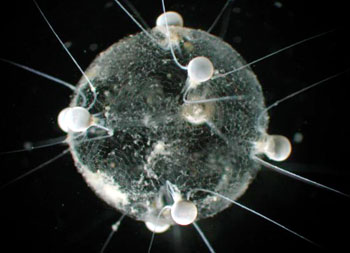![[Metroactive Features]](/features/gifs/feat468.gif)
[ Features Index | Silicon Valley | Metroactive Home | Archives ]
It's A Small World: In 1962, Osamu Shimomura discovered the protein responsible for many bioluminescent effects.
The Shining Path
Three Scientists Who Saw The Light
If it weren't for these three 20th-century pioneers of glow science, organic luminescence and fluorescence might still be the stuff of anecdotal evidence:
* Otis Barton, another adventurer who was also an engineering student, met Beebe's challenge by designing the first true deep-water submersible. To counter the effects of pressure at those depths, it was designed as a sphere. The first time that creatures like lanternfish and anglerfish were seen in their deep sea environment was in 1934, when the two men descended nearly a half mile into the ocean near Bermuda. The dive was so successful that Beebe later wrote, "At 2000 feet I made careful count and found that there was never less than ten or more lights--pale yellow and pale bluish--in sight at any one time." Beebe had pushed the limits of ocean exploration to new depths. He also revealed not an ocean comprised of absolute murky darkness, as long thought, but a world lit by countless creatures.
* Nearly three decades later, a scientist by the name of Osamu Shimomura, considered by many to be the godfather of bioluminescence and fluorescence research, began to isolate the causes of those lights. In 1962, he discovered that a three-dimensional protein, aequorin, was responsible for some of the bioluminescent effects. An abundant species of jellyfish known as Aequorea victoria bloomed in huge numbers in Friday Harbor, Wash. Shimomura collected and studied aequorea for one simple reason: "to understand how the jellyfish chemically emits light." Later, the GFP present in aequorea was also discovered. Asked if he foresaw the current applications of GFP and bioluminescence in gene research at the time, he replied, "You must wind your clock [back] 40 years. There wasn't such knowledge of the gene, cloning or 3D structure of a protein. What can one foresee?"
[ Silicon Valley | Metroactive Home | Archives ]
Copyright © Metro Publishing Inc. Metroactive is affiliated with the Boulevards Network.
For more information about the San Jose/Silicon Valley area, visit sanjose.com.
![]()

Photograph by Steven Haddock
* William Beebe was a famous naturalist, adventurer and author who spent a great deal of time at sea conducting research on deep sea creatures in the early part of the century. He realized that many of the delicate creatures that they were hauling up in their nets were being destroyed, and he wanted to see these deep sea specimens in their natural environment. At that time, however, diving technology was limited to diving bells, which could only be used to 525 feet. Beebe needed to create a vessel capable of reaching the creatures in the midwaters, around 3,000 feet.
Send a letter to the editor about this story
.
From the June 6-12, 2002 issue of Metro, Silicon Valley's Weekly Newspaper.